Audit Risk Analysis: Events, Ethical Issues, Procedures and Reporting
VerifiedAdded on 2022/12/30
|9
|2340
|27
Homework Assignment
AI Summary
This assignment provides a comprehensive analysis of audit risk, encompassing various aspects crucial to financial auditing. It begins by examining subsequent events, categorizing them based on their impact on financial statements and detailing appropriate accounting treatments and disclosures. The assignment then delves into ethical issues, specifically focusing on auditor independence and potential conflicts of interest, providing examples of situations that compromise auditor objectivity and discussing the ethical implications. Furthermore, it outlines key audit procedures, including obtaining and evaluating audit evidence from diverse sources like valuation reports and bank loan documents, emphasizing the importance of sufficient and appropriate evidence. The assignment also covers reporting requirements, discussing points for inclusion in an audit committee report and actions to be taken when management fails to address recommendations. Finally, it addresses the challenges of auditing in computerised environments, exploring the complexities and limitations of auditing around computer systems.
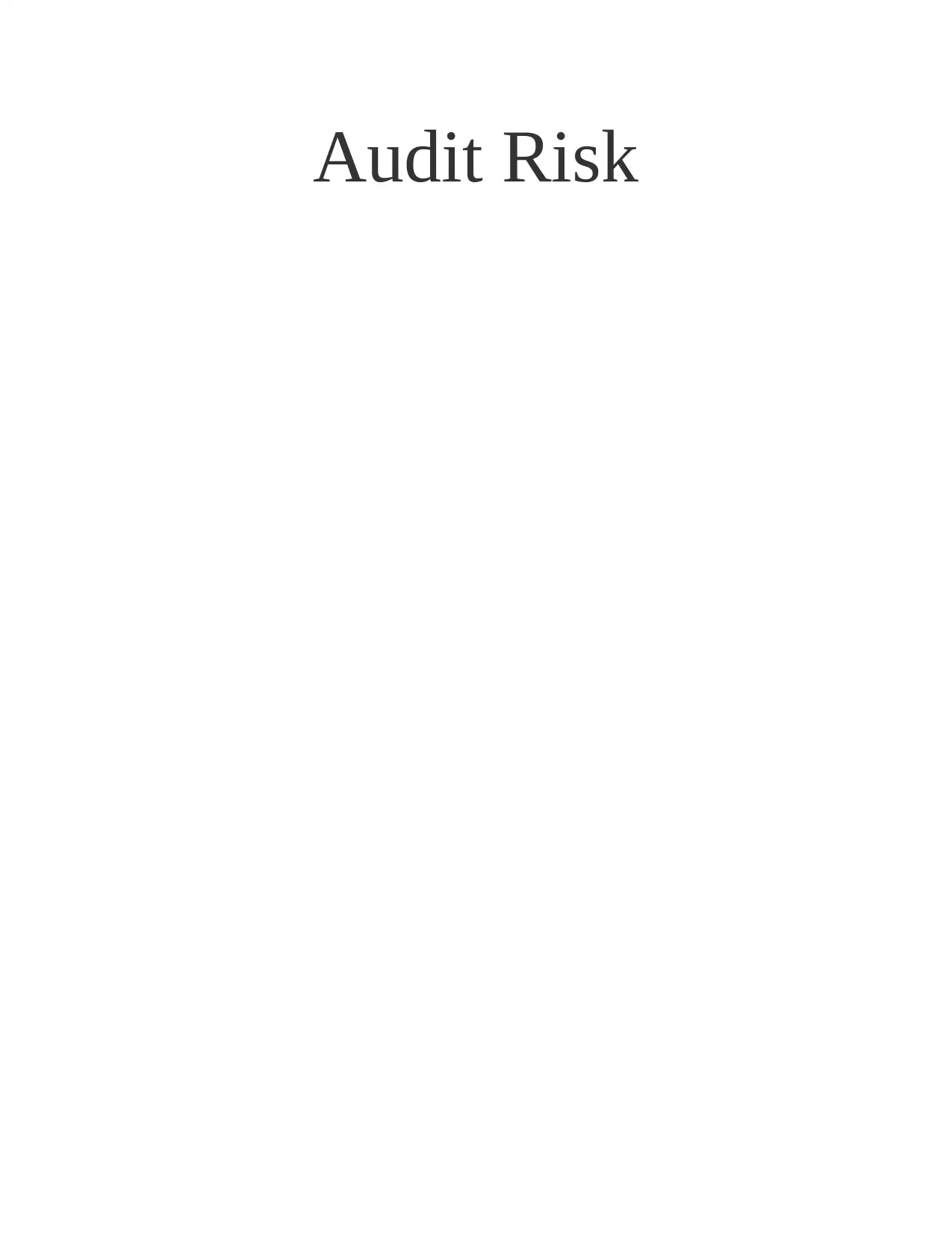
Audit Risk
Paraphrase This Document
Need a fresh take? Get an instant paraphrase of this document with our AI Paraphraser
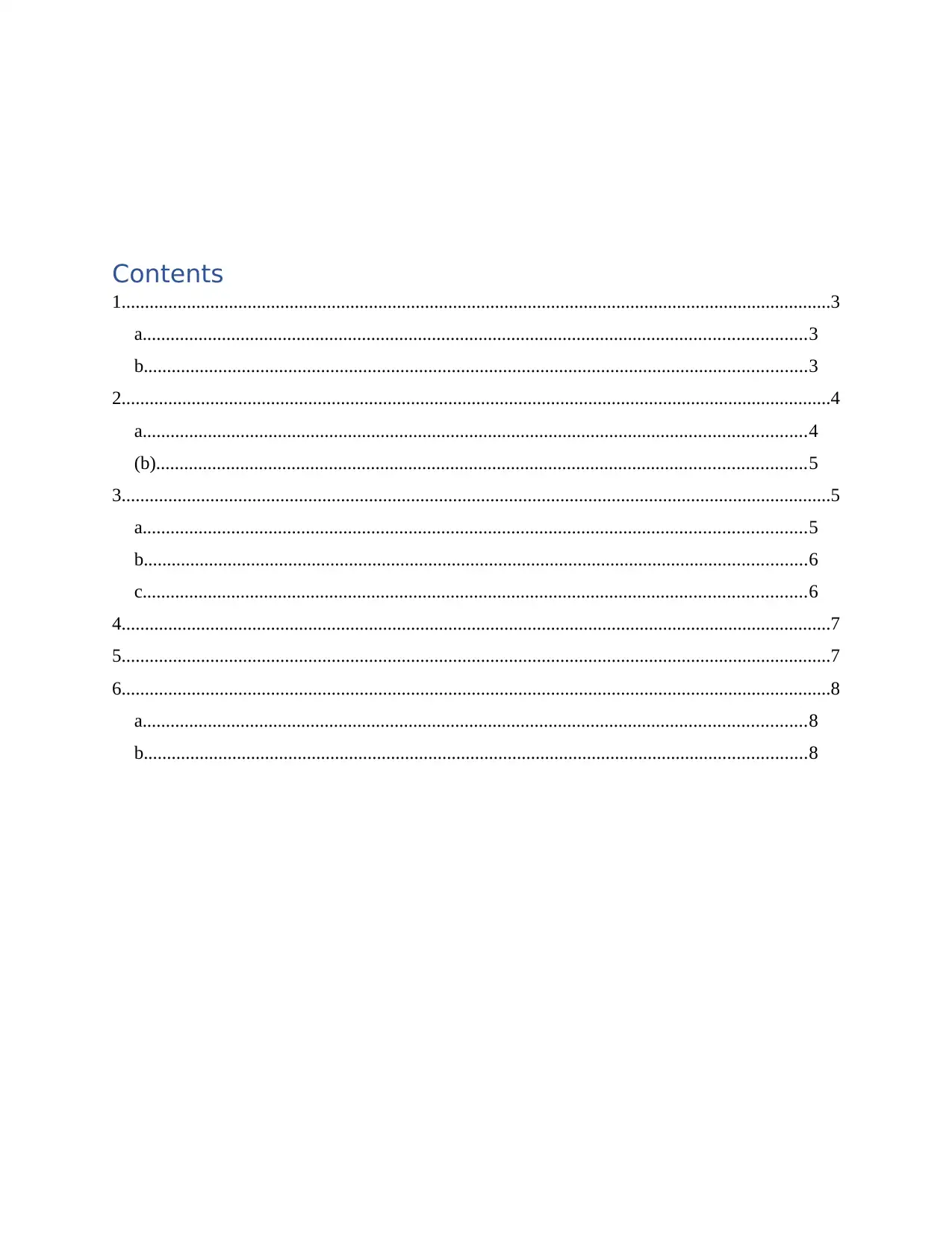
Contents
1........................................................................................................................................................3
a..............................................................................................................................................3
b..............................................................................................................................................3
2........................................................................................................................................................4
a..............................................................................................................................................4
(b)...........................................................................................................................................5
3........................................................................................................................................................5
a..............................................................................................................................................5
b..............................................................................................................................................6
c..............................................................................................................................................6
4........................................................................................................................................................7
5........................................................................................................................................................7
6........................................................................................................................................................8
a..............................................................................................................................................8
b..............................................................................................................................................8
1........................................................................................................................................................3
a..............................................................................................................................................3
b..............................................................................................................................................3
2........................................................................................................................................................4
a..............................................................................................................................................4
(b)...........................................................................................................................................5
3........................................................................................................................................................5
a..............................................................................................................................................5
b..............................................................................................................................................6
c..............................................................................................................................................6
4........................................................................................................................................................7
5........................................................................................................................................................7
6........................................................................................................................................................8
a..............................................................................................................................................8
b..............................................................................................................................................8
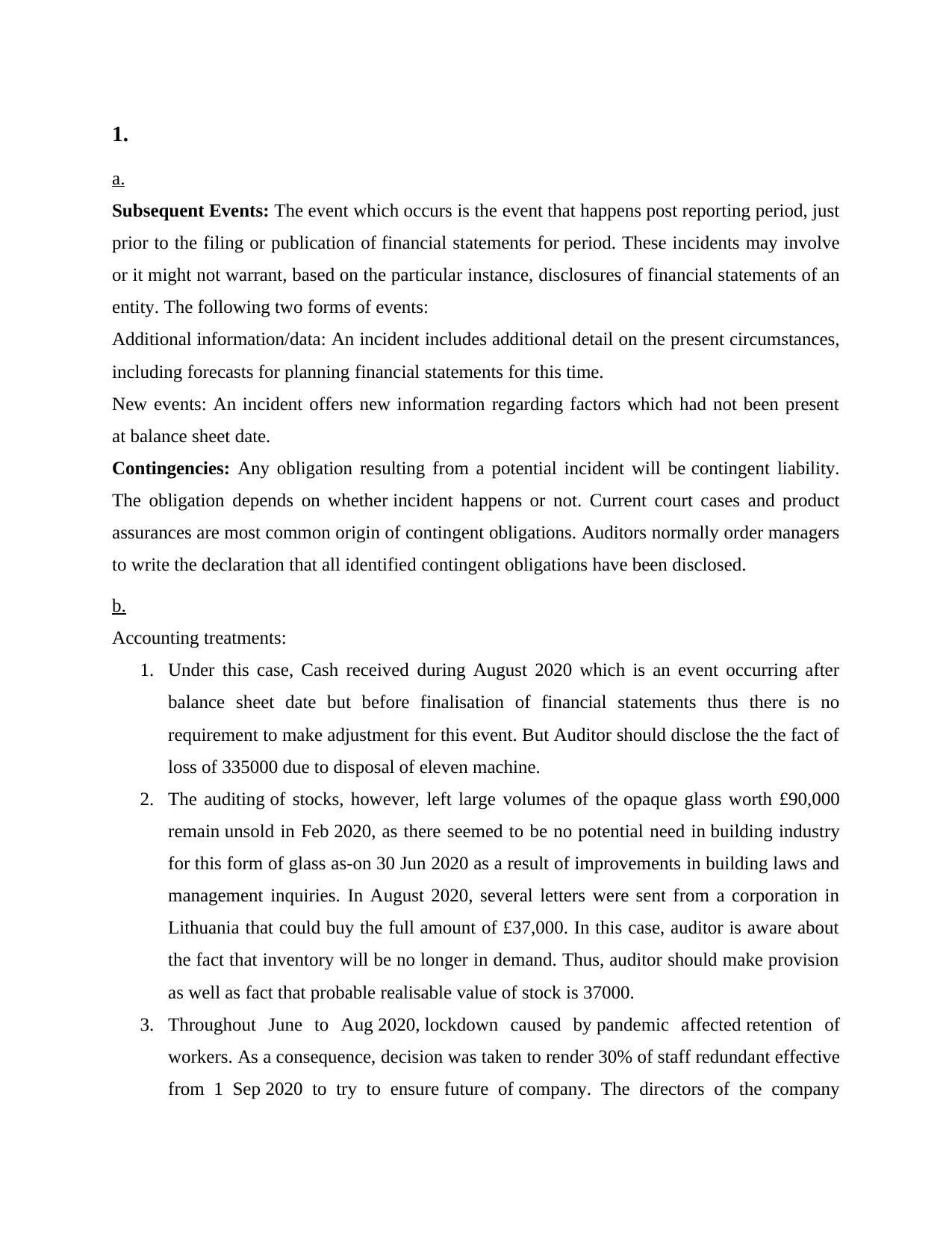
1.
a.
Subsequent Events: The event which occurs is the event that happens post reporting period, just
prior to the filing or publication of financial statements for period. These incidents may involve
or it might not warrant, based on the particular instance, disclosures of financial statements of an
entity. The following two forms of events:
Additional information/data: An incident includes additional detail on the present circumstances,
including forecasts for planning financial statements for this time.
New events: An incident offers new information regarding factors which had not been present
at balance sheet date.
Contingencies: Any obligation resulting from a potential incident will be contingent liability.
The obligation depends on whether incident happens or not. Current court cases and product
assurances are most common origin of contingent obligations. Auditors normally order managers
to write the declaration that all identified contingent obligations have been disclosed.
b.
Accounting treatments:
1. Under this case, Cash received during August 2020 which is an event occurring after
balance sheet date but before finalisation of financial statements thus there is no
requirement to make adjustment for this event. But Auditor should disclose the the fact of
loss of 335000 due to disposal of eleven machine.
2. The auditing of stocks, however, left large volumes of the opaque glass worth £90,000
remain unsold in Feb 2020, as there seemed to be no potential need in building industry
for this form of glass as-on 30 Jun 2020 as a result of improvements in building laws and
management inquiries. In August 2020, several letters were sent from a corporation in
Lithuania that could buy the full amount of £37,000. In this case, auditor is aware about
the fact that inventory will be no longer in demand. Thus, auditor should make provision
as well as fact that probable realisable value of stock is 37000.
3. Throughout June to Aug 2020, lockdown caused by pandemic affected retention of
workers. As a consequence, decision was taken to render 30% of staff redundant effective
from 1 Sep 2020 to try to ensure future of company. The directors of the company
a.
Subsequent Events: The event which occurs is the event that happens post reporting period, just
prior to the filing or publication of financial statements for period. These incidents may involve
or it might not warrant, based on the particular instance, disclosures of financial statements of an
entity. The following two forms of events:
Additional information/data: An incident includes additional detail on the present circumstances,
including forecasts for planning financial statements for this time.
New events: An incident offers new information regarding factors which had not been present
at balance sheet date.
Contingencies: Any obligation resulting from a potential incident will be contingent liability.
The obligation depends on whether incident happens or not. Current court cases and product
assurances are most common origin of contingent obligations. Auditors normally order managers
to write the declaration that all identified contingent obligations have been disclosed.
b.
Accounting treatments:
1. Under this case, Cash received during August 2020 which is an event occurring after
balance sheet date but before finalisation of financial statements thus there is no
requirement to make adjustment for this event. But Auditor should disclose the the fact of
loss of 335000 due to disposal of eleven machine.
2. The auditing of stocks, however, left large volumes of the opaque glass worth £90,000
remain unsold in Feb 2020, as there seemed to be no potential need in building industry
for this form of glass as-on 30 Jun 2020 as a result of improvements in building laws and
management inquiries. In August 2020, several letters were sent from a corporation in
Lithuania that could buy the full amount of £37,000. In this case, auditor is aware about
the fact that inventory will be no longer in demand. Thus, auditor should make provision
as well as fact that probable realisable value of stock is 37000.
3. Throughout June to Aug 2020, lockdown caused by pandemic affected retention of
workers. As a consequence, decision was taken to render 30% of staff redundant effective
from 1 Sep 2020 to try to ensure future of company. The directors of the company
⊘ This is a preview!⊘
Do you want full access?
Subscribe today to unlock all pages.

Trusted by 1+ million students worldwide
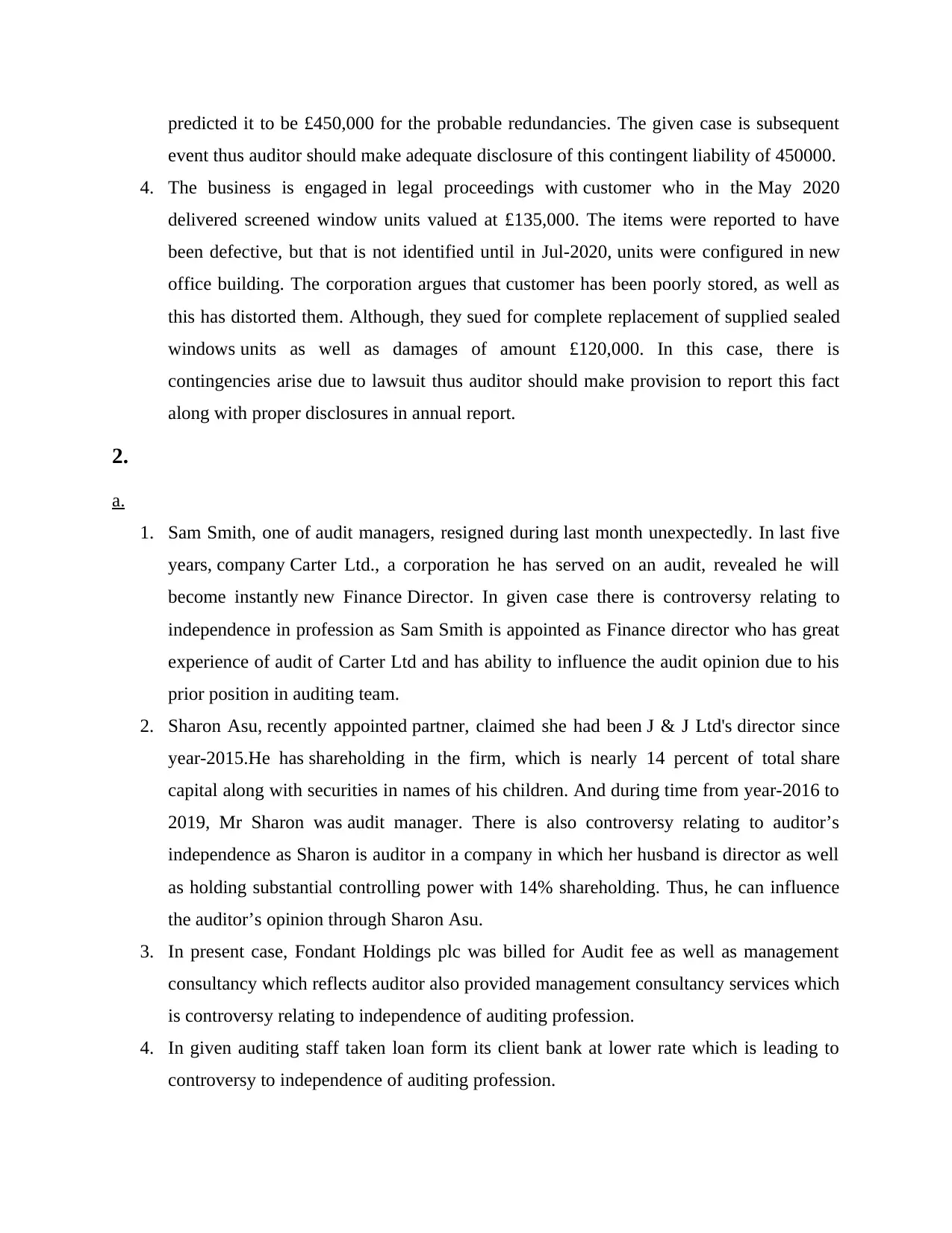
predicted it to be £450,000 for the probable redundancies. The given case is subsequent
event thus auditor should make adequate disclosure of this contingent liability of 450000.
4. The business is engaged in legal proceedings with customer who in the May 2020
delivered screened window units valued at £135,000. The items were reported to have
been defective, but that is not identified until in Jul-2020, units were configured in new
office building. The corporation argues that customer has been poorly stored, as well as
this has distorted them. Although, they sued for complete replacement of supplied sealed
windows units as well as damages of amount £120,000. In this case, there is
contingencies arise due to lawsuit thus auditor should make provision to report this fact
along with proper disclosures in annual report.
2.
a.
1. Sam Smith, one of audit managers, resigned during last month unexpectedly. In last five
years, company Carter Ltd., a corporation he has served on an audit, revealed he will
become instantly new Finance Director. In given case there is controversy relating to
independence in profession as Sam Smith is appointed as Finance director who has great
experience of audit of Carter Ltd and has ability to influence the audit opinion due to his
prior position in auditing team.
2. Sharon Asu, recently appointed partner, claimed she had been J & J Ltd's director since
year-2015.He has shareholding in the firm, which is nearly 14 percent of total share
capital along with securities in names of his children. And during time from year-2016 to
2019, Mr Sharon was audit manager. There is also controversy relating to auditor’s
independence as Sharon is auditor in a company in which her husband is director as well
as holding substantial controlling power with 14% shareholding. Thus, he can influence
the auditor’s opinion through Sharon Asu.
3. In present case, Fondant Holdings plc was billed for Audit fee as well as management
consultancy which reflects auditor also provided management consultancy services which
is controversy relating to independence of auditing profession.
4. In given auditing staff taken loan form its client bank at lower rate which is leading to
controversy to independence of auditing profession.
event thus auditor should make adequate disclosure of this contingent liability of 450000.
4. The business is engaged in legal proceedings with customer who in the May 2020
delivered screened window units valued at £135,000. The items were reported to have
been defective, but that is not identified until in Jul-2020, units were configured in new
office building. The corporation argues that customer has been poorly stored, as well as
this has distorted them. Although, they sued for complete replacement of supplied sealed
windows units as well as damages of amount £120,000. In this case, there is
contingencies arise due to lawsuit thus auditor should make provision to report this fact
along with proper disclosures in annual report.
2.
a.
1. Sam Smith, one of audit managers, resigned during last month unexpectedly. In last five
years, company Carter Ltd., a corporation he has served on an audit, revealed he will
become instantly new Finance Director. In given case there is controversy relating to
independence in profession as Sam Smith is appointed as Finance director who has great
experience of audit of Carter Ltd and has ability to influence the audit opinion due to his
prior position in auditing team.
2. Sharon Asu, recently appointed partner, claimed she had been J & J Ltd's director since
year-2015.He has shareholding in the firm, which is nearly 14 percent of total share
capital along with securities in names of his children. And during time from year-2016 to
2019, Mr Sharon was audit manager. There is also controversy relating to auditor’s
independence as Sharon is auditor in a company in which her husband is director as well
as holding substantial controlling power with 14% shareholding. Thus, he can influence
the auditor’s opinion through Sharon Asu.
3. In present case, Fondant Holdings plc was billed for Audit fee as well as management
consultancy which reflects auditor also provided management consultancy services which
is controversy relating to independence of auditing profession.
4. In given auditing staff taken loan form its client bank at lower rate which is leading to
controversy to independence of auditing profession.
Paraphrase This Document
Need a fresh take? Get an instant paraphrase of this document with our AI Paraphraser
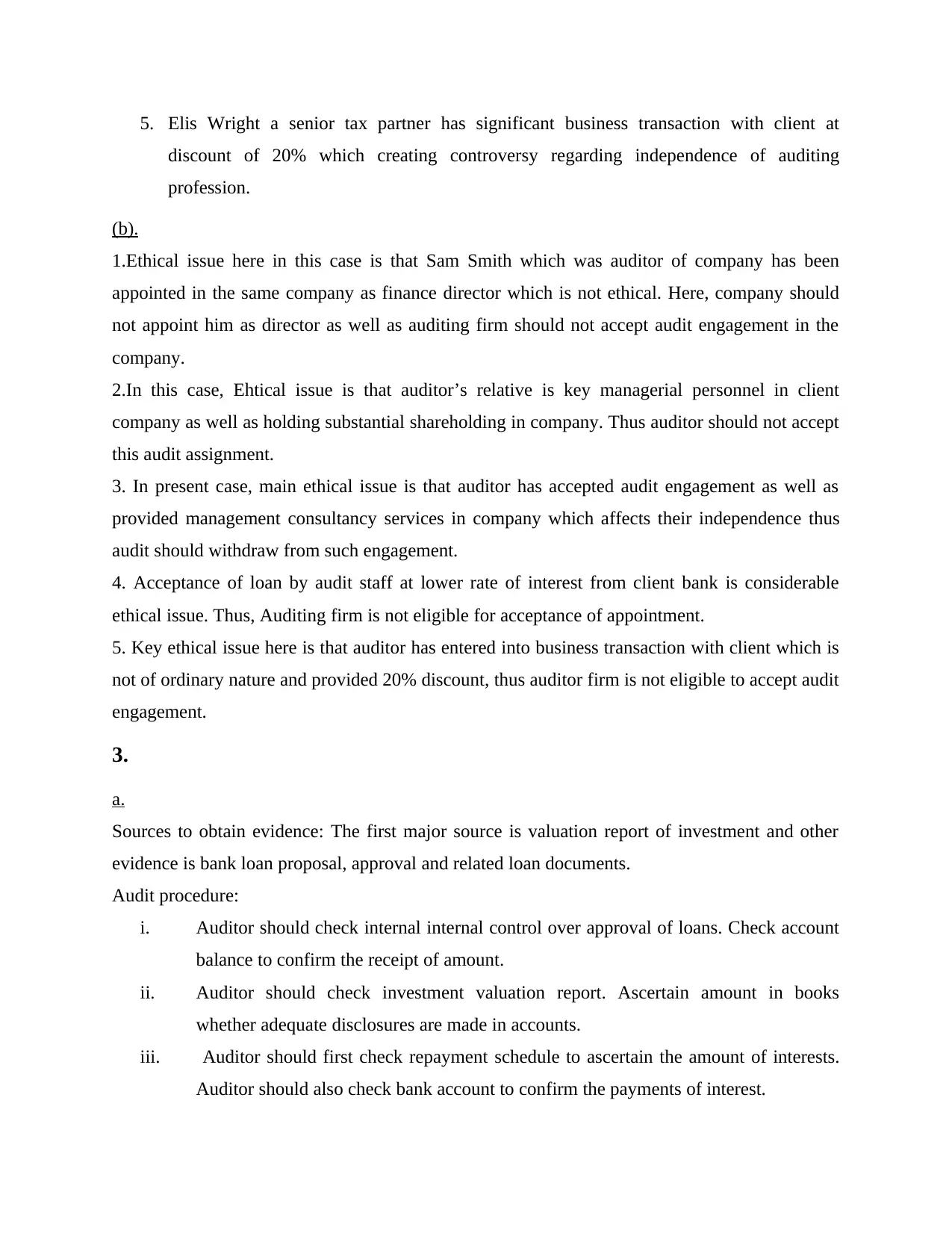
5. Elis Wright a senior tax partner has significant business transaction with client at
discount of 20% which creating controversy regarding independence of auditing
profession.
(b).
1.Ethical issue here in this case is that Sam Smith which was auditor of company has been
appointed in the same company as finance director which is not ethical. Here, company should
not appoint him as director as well as auditing firm should not accept audit engagement in the
company.
2.In this case, Ehtical issue is that auditor’s relative is key managerial personnel in client
company as well as holding substantial shareholding in company. Thus auditor should not accept
this audit assignment.
3. In present case, main ethical issue is that auditor has accepted audit engagement as well as
provided management consultancy services in company which affects their independence thus
audit should withdraw from such engagement.
4. Acceptance of loan by audit staff at lower rate of interest from client bank is considerable
ethical issue. Thus, Auditing firm is not eligible for acceptance of appointment.
5. Key ethical issue here is that auditor has entered into business transaction with client which is
not of ordinary nature and provided 20% discount, thus auditor firm is not eligible to accept audit
engagement.
3.
a.
Sources to obtain evidence: The first major source is valuation report of investment and other
evidence is bank loan proposal, approval and related loan documents.
Audit procedure:
i. Auditor should check internal internal control over approval of loans. Check account
balance to confirm the receipt of amount.
ii. Auditor should check investment valuation report. Ascertain amount in books
whether adequate disclosures are made in accounts.
iii. Auditor should first check repayment schedule to ascertain the amount of interests.
Auditor should also check bank account to confirm the payments of interest.
discount of 20% which creating controversy regarding independence of auditing
profession.
(b).
1.Ethical issue here in this case is that Sam Smith which was auditor of company has been
appointed in the same company as finance director which is not ethical. Here, company should
not appoint him as director as well as auditing firm should not accept audit engagement in the
company.
2.In this case, Ehtical issue is that auditor’s relative is key managerial personnel in client
company as well as holding substantial shareholding in company. Thus auditor should not accept
this audit assignment.
3. In present case, main ethical issue is that auditor has accepted audit engagement as well as
provided management consultancy services in company which affects their independence thus
audit should withdraw from such engagement.
4. Acceptance of loan by audit staff at lower rate of interest from client bank is considerable
ethical issue. Thus, Auditing firm is not eligible for acceptance of appointment.
5. Key ethical issue here is that auditor has entered into business transaction with client which is
not of ordinary nature and provided 20% discount, thus auditor firm is not eligible to accept audit
engagement.
3.
a.
Sources to obtain evidence: The first major source is valuation report of investment and other
evidence is bank loan proposal, approval and related loan documents.
Audit procedure:
i. Auditor should check internal internal control over approval of loans. Check account
balance to confirm the receipt of amount.
ii. Auditor should check investment valuation report. Ascertain amount in books
whether adequate disclosures are made in accounts.
iii. Auditor should first check repayment schedule to ascertain the amount of interests.
Auditor should also check bank account to confirm the payments of interest.
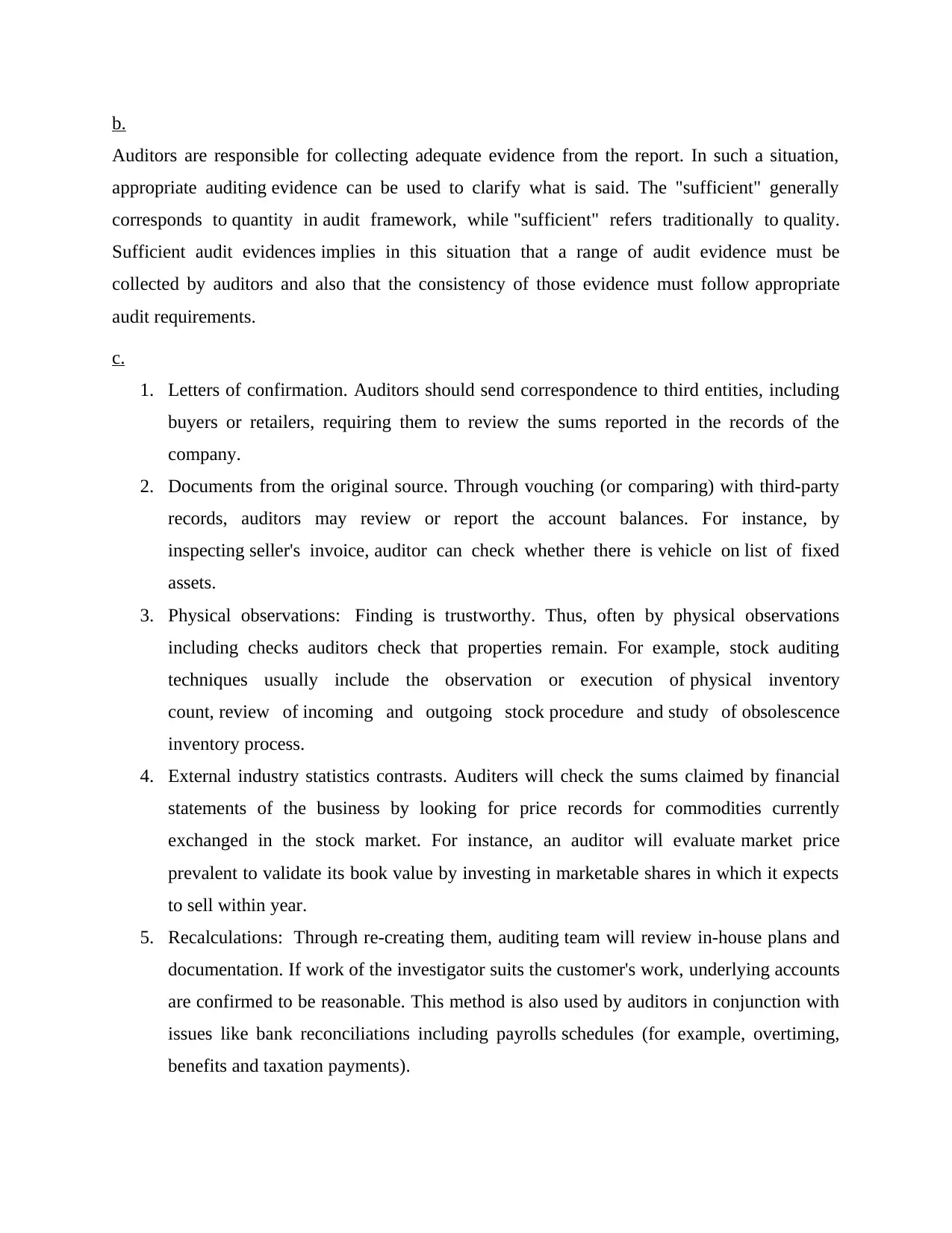
b.
Auditors are responsible for collecting adequate evidence from the report. In such a situation,
appropriate auditing evidence can be used to clarify what is said. The "sufficient" generally
corresponds to quantity in audit framework, while "sufficient" refers traditionally to quality.
Sufficient audit evidences implies in this situation that a range of audit evidence must be
collected by auditors and also that the consistency of those evidence must follow appropriate
audit requirements.
c.
1. Letters of confirmation. Auditors should send correspondence to third entities, including
buyers or retailers, requiring them to review the sums reported in the records of the
company.
2. Documents from the original source. Through vouching (or comparing) with third-party
records, auditors may review or report the account balances. For instance, by
inspecting seller's invoice, auditor can check whether there is vehicle on list of fixed
assets.
3. Physical observations: Finding is trustworthy. Thus, often by physical observations
including checks auditors check that properties remain. For example, stock auditing
techniques usually include the observation or execution of physical inventory
count, review of incoming and outgoing stock procedure and study of obsolescence
inventory process.
4. External industry statistics contrasts. Auditers will check the sums claimed by financial
statements of the business by looking for price records for commodities currently
exchanged in the stock market. For instance, an auditor will evaluate market price
prevalent to validate its book value by investing in marketable shares in which it expects
to sell within year.
5. Recalculations: Through re-creating them, auditing team will review in-house plans and
documentation. If work of the investigator suits the customer's work, underlying accounts
are confirmed to be reasonable. This method is also used by auditors in conjunction with
issues like bank reconciliations including payrolls schedules (for example, overtiming,
benefits and taxation payments).
Auditors are responsible for collecting adequate evidence from the report. In such a situation,
appropriate auditing evidence can be used to clarify what is said. The "sufficient" generally
corresponds to quantity in audit framework, while "sufficient" refers traditionally to quality.
Sufficient audit evidences implies in this situation that a range of audit evidence must be
collected by auditors and also that the consistency of those evidence must follow appropriate
audit requirements.
c.
1. Letters of confirmation. Auditors should send correspondence to third entities, including
buyers or retailers, requiring them to review the sums reported in the records of the
company.
2. Documents from the original source. Through vouching (or comparing) with third-party
records, auditors may review or report the account balances. For instance, by
inspecting seller's invoice, auditor can check whether there is vehicle on list of fixed
assets.
3. Physical observations: Finding is trustworthy. Thus, often by physical observations
including checks auditors check that properties remain. For example, stock auditing
techniques usually include the observation or execution of physical inventory
count, review of incoming and outgoing stock procedure and study of obsolescence
inventory process.
4. External industry statistics contrasts. Auditers will check the sums claimed by financial
statements of the business by looking for price records for commodities currently
exchanged in the stock market. For instance, an auditor will evaluate market price
prevalent to validate its book value by investing in marketable shares in which it expects
to sell within year.
5. Recalculations: Through re-creating them, auditing team will review in-house plans and
documentation. If work of the investigator suits the customer's work, underlying accounts
are confirmed to be reasonable. This method is also used by auditors in conjunction with
issues like bank reconciliations including payrolls schedules (for example, overtiming,
benefits and taxation payments).
⊘ This is a preview!⊘
Do you want full access?
Subscribe today to unlock all pages.

Trusted by 1+ million students worldwide
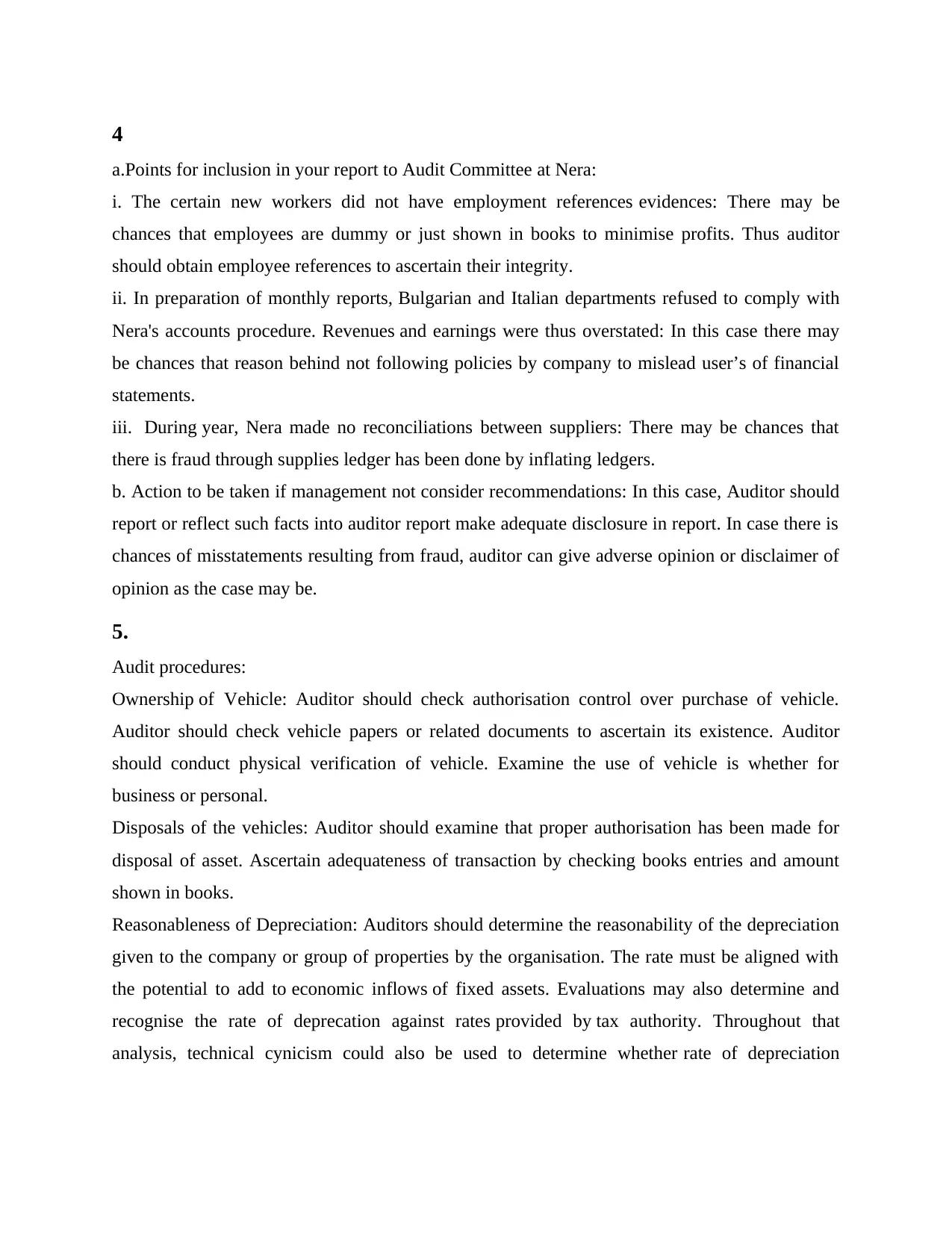
4
a.Points for inclusion in your report to Audit Committee at Nera:
i. The certain new workers did not have employment references evidences: There may be
chances that employees are dummy or just shown in books to minimise profits. Thus auditor
should obtain employee references to ascertain their integrity.
ii. In preparation of monthly reports, Bulgarian and Italian departments refused to comply with
Nera's accounts procedure. Revenues and earnings were thus overstated: In this case there may
be chances that reason behind not following policies by company to mislead user’s of financial
statements.
iii. During year, Nera made no reconciliations between suppliers: There may be chances that
there is fraud through supplies ledger has been done by inflating ledgers.
b. Action to be taken if management not consider recommendations: In this case, Auditor should
report or reflect such facts into auditor report make adequate disclosure in report. In case there is
chances of misstatements resulting from fraud, auditor can give adverse opinion or disclaimer of
opinion as the case may be.
5.
Audit procedures:
Ownership of Vehicle: Auditor should check authorisation control over purchase of vehicle.
Auditor should check vehicle papers or related documents to ascertain its existence. Auditor
should conduct physical verification of vehicle. Examine the use of vehicle is whether for
business or personal.
Disposals of the vehicles: Auditor should examine that proper authorisation has been made for
disposal of asset. Ascertain adequateness of transaction by checking books entries and amount
shown in books.
Reasonableness of Depreciation: Auditors should determine the reasonability of the depreciation
given to the company or group of properties by the organisation. The rate must be aligned with
the potential to add to economic inflows of fixed assets. Evaluations may also determine and
recognise the rate of deprecation against rates provided by tax authority. Throughout that
analysis, technical cynicism could also be used to determine whether rate of depreciation
a.Points for inclusion in your report to Audit Committee at Nera:
i. The certain new workers did not have employment references evidences: There may be
chances that employees are dummy or just shown in books to minimise profits. Thus auditor
should obtain employee references to ascertain their integrity.
ii. In preparation of monthly reports, Bulgarian and Italian departments refused to comply with
Nera's accounts procedure. Revenues and earnings were thus overstated: In this case there may
be chances that reason behind not following policies by company to mislead user’s of financial
statements.
iii. During year, Nera made no reconciliations between suppliers: There may be chances that
there is fraud through supplies ledger has been done by inflating ledgers.
b. Action to be taken if management not consider recommendations: In this case, Auditor should
report or reflect such facts into auditor report make adequate disclosure in report. In case there is
chances of misstatements resulting from fraud, auditor can give adverse opinion or disclaimer of
opinion as the case may be.
5.
Audit procedures:
Ownership of Vehicle: Auditor should check authorisation control over purchase of vehicle.
Auditor should check vehicle papers or related documents to ascertain its existence. Auditor
should conduct physical verification of vehicle. Examine the use of vehicle is whether for
business or personal.
Disposals of the vehicles: Auditor should examine that proper authorisation has been made for
disposal of asset. Ascertain adequateness of transaction by checking books entries and amount
shown in books.
Reasonableness of Depreciation: Auditors should determine the reasonability of the depreciation
given to the company or group of properties by the organisation. The rate must be aligned with
the potential to add to economic inflows of fixed assets. Evaluations may also determine and
recognise the rate of deprecation against rates provided by tax authority. Throughout that
analysis, technical cynicism could also be used to determine whether rate of depreciation
Paraphrase This Document
Need a fresh take? Get an instant paraphrase of this document with our AI Paraphraser
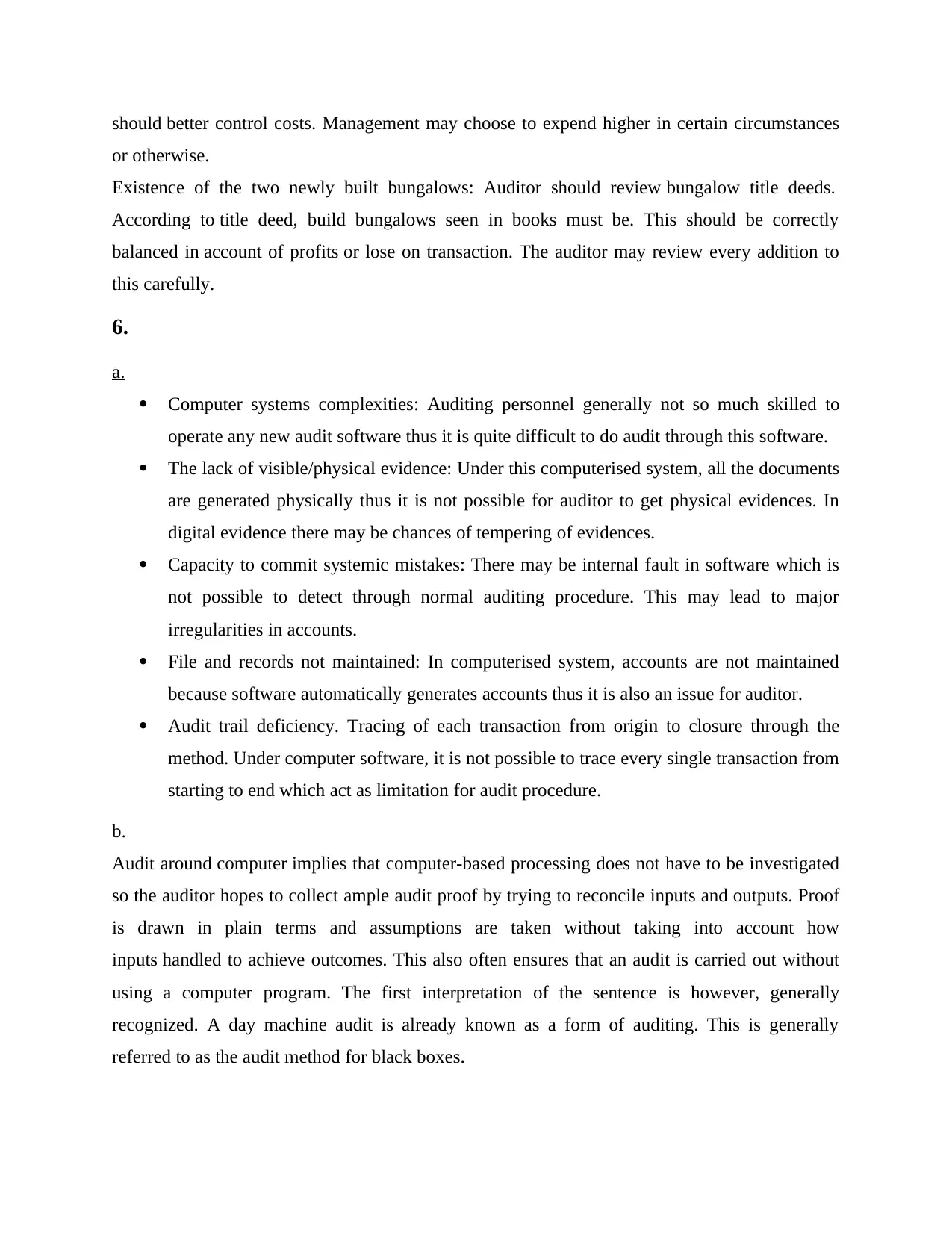
should better control costs. Management may choose to expend higher in certain circumstances
or otherwise.
Existence of the two newly built bungalows: Auditor should review bungalow title deeds.
According to title deed, build bungalows seen in books must be. This should be correctly
balanced in account of profits or lose on transaction. The auditor may review every addition to
this carefully.
6.
a.
Computer systems complexities: Auditing personnel generally not so much skilled to
operate any new audit software thus it is quite difficult to do audit through this software.
The lack of visible/physical evidence: Under this computerised system, all the documents
are generated physically thus it is not possible for auditor to get physical evidences. In
digital evidence there may be chances of tempering of evidences.
Capacity to commit systemic mistakes: There may be internal fault in software which is
not possible to detect through normal auditing procedure. This may lead to major
irregularities in accounts.
File and records not maintained: In computerised system, accounts are not maintained
because software automatically generates accounts thus it is also an issue for auditor.
Audit trail deficiency. Tracing of each transaction from origin to closure through the
method. Under computer software, it is not possible to trace every single transaction from
starting to end which act as limitation for audit procedure.
b.
Audit around computer implies that computer-based processing does not have to be investigated
so the auditor hopes to collect ample audit proof by trying to reconcile inputs and outputs. Proof
is drawn in plain terms and assumptions are taken without taking into account how
inputs handled to achieve outcomes. This also often ensures that an audit is carried out without
using a computer program. The first interpretation of the sentence is however, generally
recognized. A day machine audit is already known as a form of auditing. This is generally
referred to as the audit method for black boxes.
or otherwise.
Existence of the two newly built bungalows: Auditor should review bungalow title deeds.
According to title deed, build bungalows seen in books must be. This should be correctly
balanced in account of profits or lose on transaction. The auditor may review every addition to
this carefully.
6.
a.
Computer systems complexities: Auditing personnel generally not so much skilled to
operate any new audit software thus it is quite difficult to do audit through this software.
The lack of visible/physical evidence: Under this computerised system, all the documents
are generated physically thus it is not possible for auditor to get physical evidences. In
digital evidence there may be chances of tempering of evidences.
Capacity to commit systemic mistakes: There may be internal fault in software which is
not possible to detect through normal auditing procedure. This may lead to major
irregularities in accounts.
File and records not maintained: In computerised system, accounts are not maintained
because software automatically generates accounts thus it is also an issue for auditor.
Audit trail deficiency. Tracing of each transaction from origin to closure through the
method. Under computer software, it is not possible to trace every single transaction from
starting to end which act as limitation for audit procedure.
b.
Audit around computer implies that computer-based processing does not have to be investigated
so the auditor hopes to collect ample audit proof by trying to reconcile inputs and outputs. Proof
is drawn in plain terms and assumptions are taken without taking into account how
inputs handled to achieve outcomes. This also often ensures that an audit is carried out without
using a computer program. The first interpretation of the sentence is however, generally
recognized. A day machine audit is already known as a form of auditing. This is generally
referred to as the audit method for black boxes.
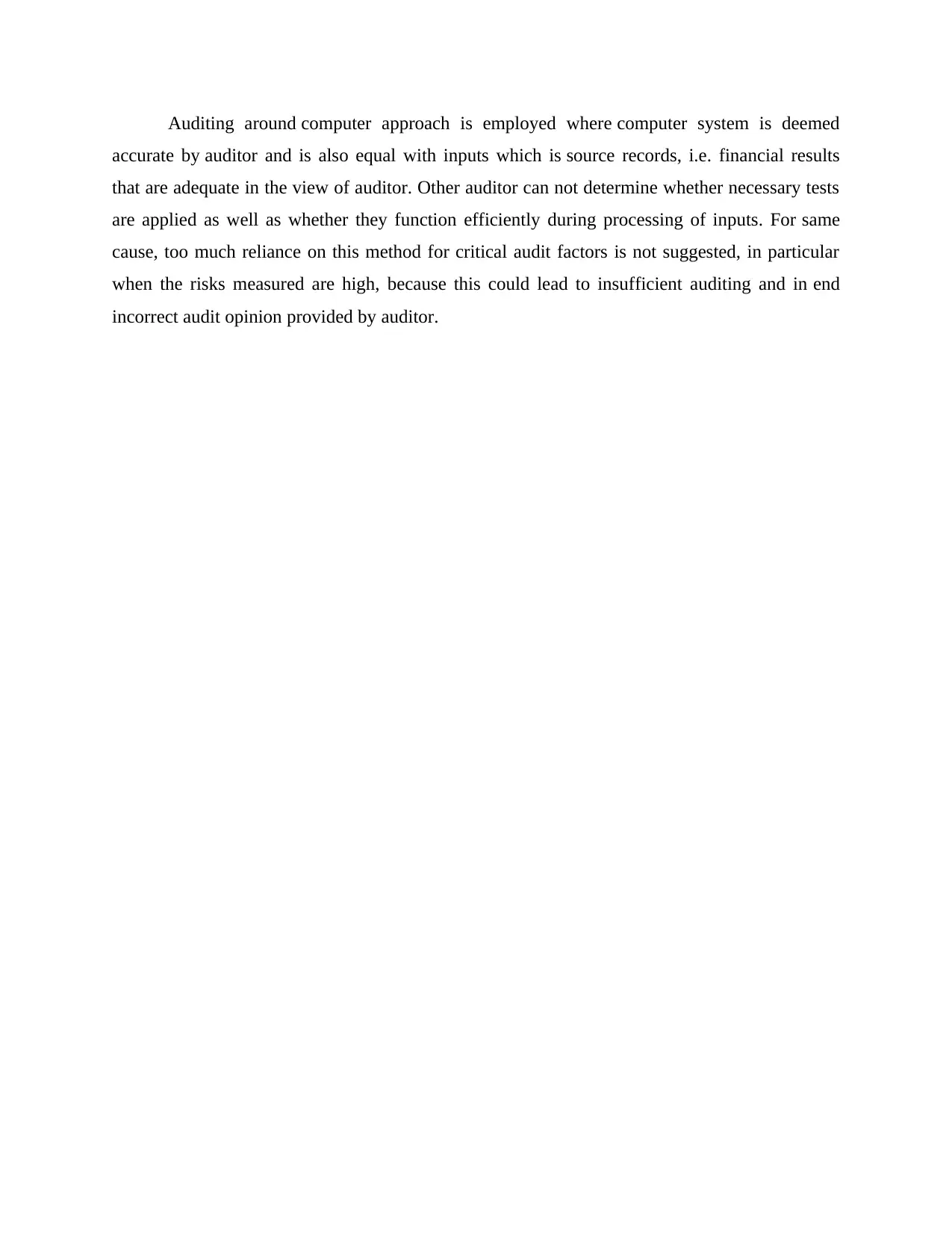
Auditing around computer approach is employed where computer system is deemed
accurate by auditor and is also equal with inputs which is source records, i.e. financial results
that are adequate in the view of auditor. Other auditor can not determine whether necessary tests
are applied as well as whether they function efficiently during processing of inputs. For same
cause, too much reliance on this method for critical audit factors is not suggested, in particular
when the risks measured are high, because this could lead to insufficient auditing and in end
incorrect audit opinion provided by auditor.
accurate by auditor and is also equal with inputs which is source records, i.e. financial results
that are adequate in the view of auditor. Other auditor can not determine whether necessary tests
are applied as well as whether they function efficiently during processing of inputs. For same
cause, too much reliance on this method for critical audit factors is not suggested, in particular
when the risks measured are high, because this could lead to insufficient auditing and in end
incorrect audit opinion provided by auditor.
⊘ This is a preview!⊘
Do you want full access?
Subscribe today to unlock all pages.

Trusted by 1+ million students worldwide
1 out of 9
Related Documents
Your All-in-One AI-Powered Toolkit for Academic Success.
+13062052269
info@desklib.com
Available 24*7 on WhatsApp / Email
![[object Object]](/_next/static/media/star-bottom.7253800d.svg)
Unlock your academic potential
Copyright © 2020–2025 A2Z Services. All Rights Reserved. Developed and managed by ZUCOL.





